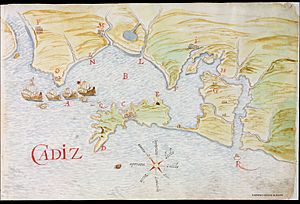Battle of Cádiz (1656) facts for kids
Quick facts for kids Battle of Cádiz (1656) |
|||||||
|---|---|---|---|---|---|---|---|
| Part of the Anglo–Spanish War (1654–1660) | |||||||
 Map of the Bay of Cádiz (1632) |
|||||||
|
|||||||
| Belligerents | |||||||
| Commanders and leaders | |||||||
| Strength | |||||||
| 8 ships | 8 ships | ||||||
| Casualties and losses | |||||||
| 5 ships | none | ||||||
The Battle of Cádiz (1656) was an important naval fight during the Anglo–Spanish War (1654–1660). In this battle, an English fleet attacked and defeated a Spanish treasure fleet near Cádiz, a city in Spain. The English managed to capture or destroy many Spanish ships, along with their valuable cargo.
Contents
Why the Battle Happened
After the First Anglo-Dutch War ended, Oliver Cromwell, who was England's leader, decided to focus on Spain. He wanted England to go back to attacking Spanish trade and shipping routes. This strategy had been very successful during the time of Queen Elizabeth I.
In August 1655, Admiral Robert Blake blocked the port of Cádiz. He hoped to stop a Spanish treasure fleet, but the fleet stayed in the Americas. Blake's fleet then sailed back to England for repairs.
The English fleet returned in April 1656. A Spanish fleet was already in Cádiz harbor, which was too strong to attack directly. So, the English admirals, Blake and Edward Montagu, sailed to Tangier for supplies.
From Tangier, the best English ships went to Lisbon. They helped with a treaty between Portugal and England. After that, they returned to blocking Cádiz. This blockade continued through the summer of 1656.
The Spanish avoided fighting, which allowed most of the English fleet to raid other Spanish and North African ports. They even sank nine Spanish ships in places like Vigo and Málaga. In July, ten English ships were sent back to England. Then, all but eight of the remaining ships went to Lisbon for more supplies. These eight ships were left under the command of Richard Stayner to continue blocking Cádiz.
The Battle Begins
Stayner's small fleet was first stationed inside Cádiz Bay. However, a strong westerly wind forced them out. On the evening of September 8, the English ships saw one of the two yearly Spanish treasure fleets.
This Spanish fleet was led by Marcos del Puerto. It included two large galleons, three private merchant ships, two armed cargo ships (called hulks), and a captured Portuguese ship. They had been waiting in Havana for two months for warships to escort them. But Blake's ongoing blockade of Cádiz had prevented any escorts from reaching them.
As darkness fell, the Spanish ships made a mistake. They thought the English squadron was just a group of fishing boats. Because of this, they did not try to escape or change course.
Fighting on the Water
When dawn broke on September 9, 1656, three of the English ships attacked the Spanish fleet. The other English ships were facing the wrong way to join the fight immediately.
Captain Stayner, on his ship the Speaker (which had 64 guns), fought and captured the Jesus Maria San Jose. This was one of the Spanish galleons, commanded by Admiral Juan de Hoyos. When it was captured, the English found a huge treasure. It included 45 tons of silver, 700 chests of indigo dye, and 700 chests of sugar.
Meanwhile, Captain Anthony Earning, on the Bridgewater (52 guns), fought the other Spanish galleon. This ship was commanded by Admiral Juan Rodriguez Calderón. After a long battle, the Spanish crew set their ship on fire as they abandoned it, and it sank. Only 90 of its crew survived. Among those who died was Francisco López de Zúñiga, 2nd Marquis of Baides, a former Governor of Chile. His wife and daughter also died, and his two young sons were taken prisoner by the English.
The English ship Plymouth (52 guns) sank one of the Spanish merchant ships. This ship was carrying 60,000 pieces of eight (a type of Spanish coin), which went down with the ship. Captain John Harman of the Tredagh (52 guns) captured another merchant ship. This ship was taken with all its cargo still on board.
The third Spanish merchant ship was run aground on the beach. The Spanish admiral, Marcus del Puerto, managed to escape on his ship, the San Francisco y San Diego. He reached Cádiz harbor along with two other smaller Spanish ships.
What Happened Next
The Battle of Cádiz was a huge loss for Spain. The English took nearly £1 million worth of goods. They also captured another £250,000 in silver. Hundreds of thousands of pounds worth of treasure were lost to the ocean when ships sank.
Ships Involved
English
- Speaker (64 guns) (Richard Stayner)
- Tredagh (52 guns) (John Harman)
- Plymouth (52 guns)
- Bridgewater (52 guns) (Anthony Earning)
- Diamond (60 guns) (Gilbert Gott)
- 3 more ships
Spanish
- San Francisco y San Diego (Capitana) (26 guns) (Marcus del Puerto) : escaped
- San Francisco Javier (Merchantman) (30 guns) (Francisco de Esquivel) : set itself on fire and exploded
- Victoria (Galleon) (20 guns) (Juan Rodriguez Calderón) : set itself on fire and sank
- Jesus, Maria y Jose (Galleon) (28 guns) (Juan de Hoyos) : captured
- Profeta Elias (Merchantman) (26 guns) (Juan de la Torre) : captured
- Rosario (Merchantman) (24 guns) (José de Paredes) : beached
- Patache (José de Pimienta) : escaped
- Captured Portuguese merchantman : escaped
See also
 In Spanish: Batalla de Cádiz (1656) para niños
In Spanish: Batalla de Cádiz (1656) para niños

